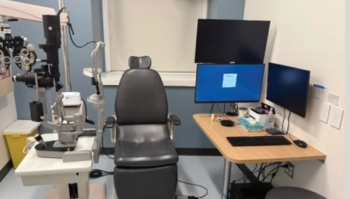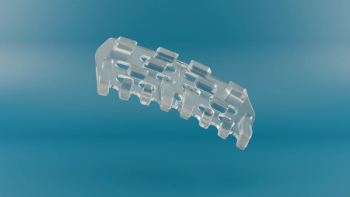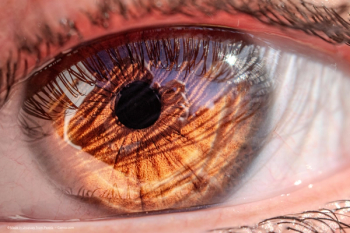
Glaucoma management with endoscopic cycloPhotocoagulatio
The Endoscopic CycloPhotocoagulation (ECP) technique provides an option for surgical glaucoma management, addressing ciliary aqueous production without the deeply destructive effects of classic ablative procedures. Dr Liegner explains
In the same evolution of glaucoma management options, cycloablative procedures have experienced considerable advancements to include more patient-friendly options that provide results for clinicians seeking an additional IOP-lowering option for their glaucoma patients.
In addition to the laser device, consisting of a fibreoptic camera with monitor, illuminating light source and the Endo Optiks laser (with HeNe aiming beam) specialized probes are required to visualize and deliver the treatment. In the ambulatory surgery centre, I have six curved probes sterilised in dedicated trays available and will occasionally switch probes if one is not adequately delivering the laser energy to the ciliary processes. Six probes satisfy the demands of two-to-four procedures each surgery day, including a comfortable full-wrap re-sterilization schedule. While each probe can cost about $1800, having six curved probes has been very useful for uninterrupted procedures and OR turnover.
I use the recommended initial power setting of 25mW, and expect to see a quality well-centred HeNe aiming beam during pre-insertion focusing and then intraocular viewing. If the aiming beam is poor quality or significantly offset outside the central 60 degrees of viewing, I will remove and clean the fibre optic tip carefully but simply, using an abrasive movement of the firmly grasped distal probe's tip against the rough sterile drapes or my surgeon's gown.
Occasionally, iris pigment or blood (after pars plana sclerostomy) clings to the fibre optic tip, necessitating this polishing technique. During the ciliary process treatment, I may increase the power to 30mW, especially for pseudo-exfoliation cases (with stark white processes, littered with debris, causing less energy absorption). However, I rarely increase power to 35mW, which often causes thermal cavitation bubbles at the tip, indicating the extra power is being absorbed and wasted well before reaching the target tissue. In this case, I will either clean the tip or swap out the probe (mandating a more thorough decontamination process).
When ECP is performed with cataract surgery, after removal of the nucleus and completing cortical clean up, I will reinstill intracameral unpreserved 1% lidocaine under the iris, followed by viscoelastic inflation of the sulcus 360°, adding a bit more additional viscoelastic posterior into the capsular bag. I will then proceed with ECP prior to IOL insertion, as the aphakic status grants more access to the more radial ciliary processes. After completing ECP, the foldable IOL is easily inserted into the bag, directing the injector a bit more posterior than usual, without additional viscoelastic, permitting one 0.80ml unit to complete the case. For scheduling purposes, ECP adds only about five minutes to the procedural time for the cataract surgery case.
During laser delivery to ciliary processes, I use a continuous sweeping movement, elicting blanching and shrinkage of each process. I will avoid delivery to the area above each process, onto iris root, as this will cause iris stromal contraction and increased atonicity of this area, which also creates postop pupil asymmetry. Pseudoexfoliation ciliary processes, white with PXF debris, require longer laser dwell time and perhaps higher power settings to cause shrinkage.
While the first part of the ECP is done through the temporal clear cornea incision, reaching approximately 240 degrees of ciliary processes, I universally create a second clear cornea keratotomy incision nasally using a back hand technique with the same cataract keratome. This grants me access to the remaining temporal 120 degrees of tissue. Because of the sweeping movement of the probe is visualized in the monitor, it now appears stereotactically reversed, such that positional and visual feedback can be confusing. Therefore, this manoeuvre requires practice and patience, but can be accomplished quickly once the surgeon becomes familiar with a single unidirectional sweeping motion.
I have installed a 6" mini-monitor (used on television cameras) onto my microscope, above and behind the ocular housing, which receives the same video signal from the ECP unit (via video outputs on the unit's back). This allows the circulating nurse to place the ECP device in the same location in the OR suite, not necessarily in the surgeon's view, while I have my monitor always directly in front of me, regardless on which side I'm operating.
ECP has been a very useful technology in my practice to meet the needs of my glaucoma patients requiring cataract surgery or pseudophakic patients being considered for trabeculectomy. It is very easy to learn and once you master a proper technique, you will notice great results in your glaucoma patients. The high safety profile of the procedure means that your postop follow up will be minimal and your patients will be very satisfied both with their visual results and the IOP control, including the possible reduction of medical expenses for glaucoma drops.
References
1. B.C. Carter. Journal of AAPOS. 2007; 11(1):34-40.
2. H. Philippin. Graefes Arch Clin Exp Ophthalmol. 2005; 243(7):684-8.
3. H.A. Holz. Curr Opin Ophthalmol. 2005; 16(2):89-93.
Newsletter
Get the essential updates shaping the future of pharma manufacturing and compliance—subscribe today to Pharmaceutical Technology and never miss a breakthrough.










































